Entrances and
Doorways:
All principal entrances should be accessible and at least one
door at each entrance should be automated.
Doorways at least 32" clear.
Wheelchair clearances in front of doorways.
- Push side - 48" for
head-on approach, 42" for parallel approach.
- Pull side - 60" for head-on approach, 48"
for parallel approach from latch, 54" for parallel approach
from hinge.
Wheelchair clearances at latch
(pull side of doors only).
- Front approach - 18” minimum 24” preferred.
- Parallel approach from latch side - none.
- Parallel approach from hinge side - 42”
with 54” wide corridor, 36” with 60” wide corridor.
- Latch clearance not necessary on automatic
doors.
Opening force for manual doors.
- Exterior doors - 15 lbf. max.
- Interior doors - 8.5 lbf.
Opening hardware - levers,
push-type or U-shaped handles..
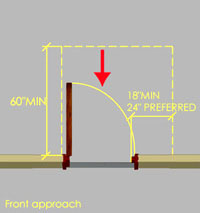
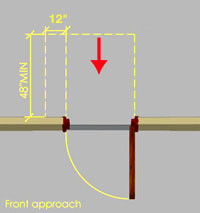
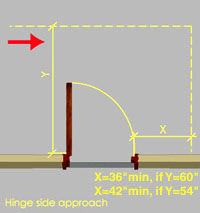
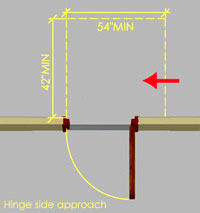
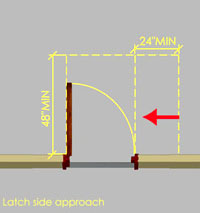
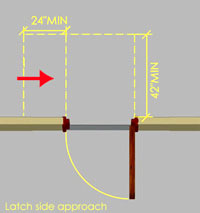
Floor
Surfaces:
Relatively non-slip.
Pile type - level loop, textured loop, level cut pile, level cut/uncut
pile.
Firm cushion, pad or backing or no cushion.
Carpet edges - fastened with trim along entire exposed edge.
Level changes (e.g., thresholds) - 1/2” maximum; beveled edges.
Ramps:
Slope:
| Slope |
|
| 1:8 |
< or = 2 ft. in existing buildings |
| 1:12 |
everywhere else |
| 1:16-1:20 |
preferred |
60" long level runoff area, top and bottom.
Handrails both sides, continuous at one side of landings, 12"
extension where handrail is not continuous.
Protection at edge of ramp surface (e.g. curbs, railing, etc.)
Circulation Routes:
At least one accessible route from each accessible entrance to
all accessible spaces.
At least two accessible means of egress or place of refuge serving
each accessible space.
Minimum width: 36".
Passing place at least 60" wide by 60" long every 200'.
Turning places at dead ends at least 60" in diameter
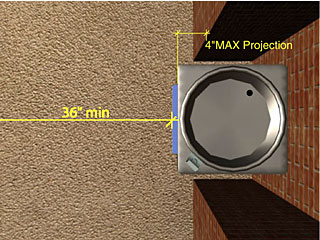
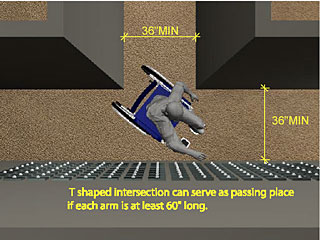
Stairs:
Design all stairs connecting levels not served by elevators to
be usable by semi-ambulatory people.
11" minimum tread depth, exclusive of nosings,
7" maximum riser height, 1½" maximum nosing; nosing not abrupt.
12" handrails extensions.
Keep out of direct paths of travel.
Elevator:
All passenger elevators should be accessible.
Automatic operation and self-leveling.
Platform at least 36" wide by 48" deep.
Automatic door reopening device - magnetic detectors or electric
eyes at 5" and 29" high.
Maximum elapsed time from onset of visible and audible signal
of car arrival until doors start to close should be determined
by dividing the distance from a point 60" in front of the farthest
call button to center of elevator door by 1.5 ft/sec.
Elevator controls mounted no higher than 48" identified by raised
alphanumeric characters, at least 5/8 " high; main floor button
in left-most column and marked by star. Braille also provided.
Car arrival signals should be both visible and audible.
Raised floor numbers at both jambs of hoistway entrances, at least
2" high and mounted 5' above the floor. Braille also provided.
An audible signal should sound as the cab passes each floor.
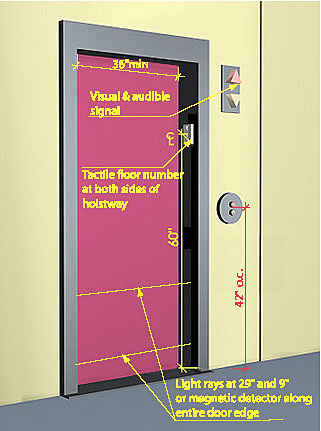
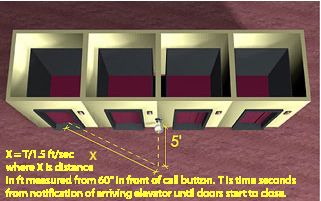
Overhanging
Objects:
Wall- or post-mounted objects: leading edges protruding over 4"
should be lower than 27" or above 80".
If overhanging edges are higher than 27" but objects are mounted
on posts or pylons, they can project 12" maximum.
80" headroom in all circulation areas.

